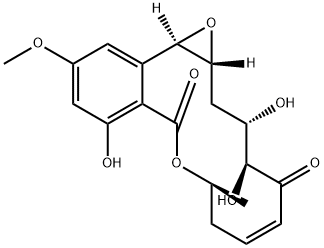Description
Hypothemycin (76958-67-3) is a potent and selective inhibitor of MEK.1-3?Acts via covalent binding to Cys residue.2?In cells, hypothemycin inhibits the MEK-ERK axis with sufficient selectivity to normalize transformed phenotypes3. Inhibits TNFα production in LPS-stimulated macrophages.4
Uses
Hypothemycin is a potent and selective inhibitor of threonine/tyrosine-specific kinase, MEK, and other protein kinases that contain a conserved cysteine residue in the ATP-binding site in in vitro studies.
General Description
A cell-permeable
cis-enone resorlic acid lactone (RAL) and (5
Z)-7-Oxozeaenol (Cat. No.
499610) analog that inhibits several kinases via an initial affinity binding to the ATP pocket, followed by a covalent adduct formation with a conserved ATP site cysteine residue of the targeted enzymes, including, but not limited to, Flt1/VEGFR-1, Flt3, cKit(D816V), MAPK1, MAPK2, MEK1, MKK6, PKCμ, PKD2, PRAK, and Tak1 (≥90% inhibition at 2 μM). Hypothemycin is also reported to inhibit two non-RAL targets (99% and 82% inhibition of TrkA and TrkB, respectively, at 2 μM), while one of the 46 putative
cis-enone RALs targets, namely GSK-3α, is shown not to be affected. Hypothemycin inhibits multiple kinases involved in MAP kinase pathways and is therefore particularly effective in inhibiting BRAF(V600E)-dependent tumor growth. (5
Z)-Zeaenol (Cat. No.
499609) may serve as a negative control.
Biochem/physiol Actions
Hypothemycin, one of the highly oxygenated analogues in the group of 14-membered resorcylic acid lactones (RAL), has minor antifungal and cytotoxic activity and exhibits an in vitro anti-malarial activity with an IC50 of 2.2 μg/mL. Hypothemycin is also reported to selectively and irreversibly inhibit protein kinases that contain a conserved cysteine residue (Cys166) that is located within the ATP-binding domain. Though this group accounts for less then 10% of all identified kinases, there are several targets implicated in aberrant cellular proliferation such as ERKs, MEK, FMS-like tyrosine kinase protein (FLT), and platelet-derived growth factor receptors (PDGFR). In cell culture, hypothemycin displays potent cytotoxicity against cancer cell lines that are dependent on certain activating kinase mutations. Additionally, hypothemycin demonstrates significant tumor growth inhibition in at least three separate murine xenograft models. Hypothemycin also inhibits the production of several cytokines such as IL2, IL6, IFNγ, and TNFα.
References
1) Zhou et al. (1999), Resorcylic acid lactones: naturally occurring potent and selective inhibitors of MEK; J. Antibiot., 52 1086
2) Schirmer et al. (2006), Targeted covalent inactivation of protein kinases by resorcylic acid lactone polyketides; Proc. Natl. Acad. Sci. USA, 103 4234
3) Fukazawa et al. (2010), The resorcylic acid lactone hypothemycin selectively inhibits the mitogen-activated protein kinase kinase-extracellular signal-regulated kinase pathway in cells; Biol. Pharm. Bull., 33 168
4) Park et al. (2015), Hypothemycin inhibits tumor necrosis factor-α production by tristetraprolin-dependent down-regulation of mRNA stability in lipopolysaccharide-stimulated macrophages; Int. Immunopharmacol., 29 863


